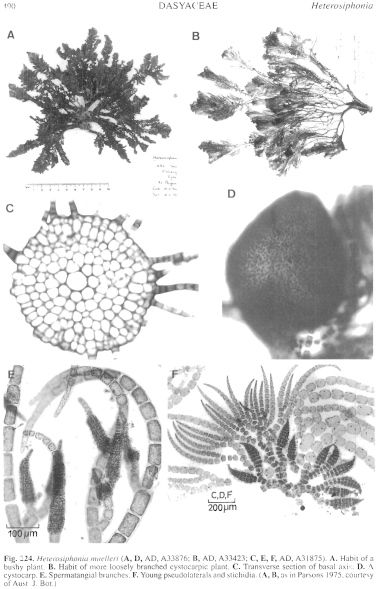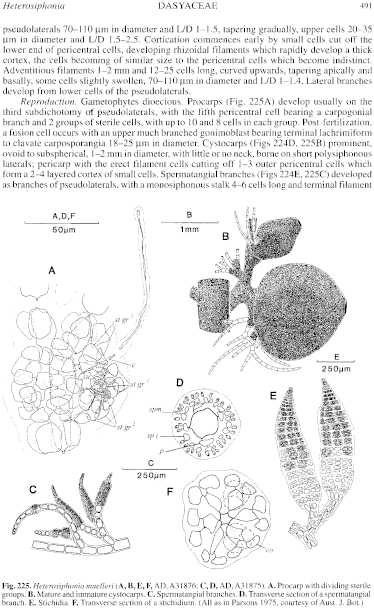|
|
|
|
|
|||||||||||
|
Electronic Flora of South Australia Species Fact Sheet
Phylum Rhodophyta – Order Ceramiales – Family Dasyaceae
Selected citations: Huisman & Walker 1990: 428. Lucas 1912: 159; 1929a: 23; 1929b: 52. Lucas & Perrin 1947: 319, fig. 154. May 1965: 381. Mazza 1910: No. 353. Parsons 1975: 626, figs 20–22, 44. Silva et al. 1996: 442. Womersley 1950: 182; 1966: 152.
Synonyms
Dasya muelleri Sonder 1855: 525; 1881: 36. J. Agardh 1863: 1196; 1890a: 84, pl. 3 fig. 1. Harvey 1858: pl. 31; 1859b: 303; 1863, synop.: xxiii. Kützing 1864: 29, pl. 82. Reinbold 1897: 57. Wilson 1892: 165.
Dasya plumigera Harvey 1855a: 543.
Dasya struthiopenna J. Agardh 1863: 1193; 1890a: 84. Harvey 1863, synop.: xxiii.
Heterosiphonia struthiopenna (J. Agardh) De Toni 1903: 1238. Lucas 1912: 159. Lucas & Perrin 1947: 320. May 1965: 381. Sonder 1881: 36.
Thallus (Fig. 224A, B) medium to dark red, erect, with one to several main axes 5–25 cm high, heavily corticated below and 3–4 mm in diameter, bearing alternately distichous lateral branches at intervals of 1–2 mm, in turn bearing alternately distichous, tufted, pseudolaterals; lower axes (probably perennial) clothed with monosiphonous, mostly unbranched, adventitious filaments (Fig. 224C). Holdfast flat to conical, rhizoidal, 2–7 cm across; epilithic or rarely epiphytic. Structure. Apices of axes and branches sympodial and distichous, developing 7–8 pericentral cells in alternating sequence, commencing 16–18 segments from the apex. Pseudolaterals 2–3 (–5) segments apart, (1–) 1.5–2.5 mm long, each with 3–5 lower subdichotomies (1–) 2–3 cells apart and upper unbranched ends 10–15 cells long; the basal 3–4 segments usually become polysiphonous, with 4–8 pericentral cells; lower cells of pseudolaterals 70–110 µm in diameter and L/D 1–1.5, tapering gradually, upper cells 20–35 µm in diameter and L/D 1.5–2.5. Cortication commences early by small cells cut off the lower end of pericentral cells, developing rhizoidal filaments which rapidly develop a thick cortex, the cells becoming of similar size to the pericentral cells which become indistinct. Adventitious filaments 1–2 mm and 12–25 cells long, curved upwards, tapering apically and basally, some cells slightly swollen, 70–110 µm in diameter and L/D 1–1.4. Lateral branches develop from lower cells of the pseudolaterals.
Reproduction: Gametophytes dioecious. Procarps (Fig. 225A) develop usually on the third subdichotomy of pseudolaterals, with the fifth pericentral cell bearing a carpogonial branch and 2 groups of sterile cells, with up to 10 and 8 cells in each group. Post-fertilization, a fusion cell occurs with an upper much branched gonimoblast bearing terminal lachrimiform to clavate carposporangia 18–25 µm in diameter. Cystocarps (Figs 224D, 225B) prominent, ovoid to subspherical, 1–2 mm in diameter, with little or no neck, borne on short polysiphonous laterals; pericarp with the erect filament cells cutting off 1–3 outer pericentral cells which form a 2–4 layered cortex of small cells. Spermatangial branches (Figs 224E, 225C) developed as branches of pseudolaterals, with a monosiphonous stalk 4–6 cells long and terminal filament of up to 10 cells, 100–300 µm long and 35–50 µm in diameter, with 10–15 fertile segments each with 4 pericentral cells (Fig. 225D) producing a layer of initials each forming 3–4 outer spermatangia.
Tetrasporangial stichidia (Figs 224F, 225E) occur as pseudolateral branches, usually with a polysiphonous stalk and a short terminal filament 1–6 cells long, lanceoid, 150–1500 µm long and 80–120 (–230) µm in diameter, with 20–35 fertile segments each with 6 pericentral (Fig. 225F) cells and ovoid tetrasporangia 40–55 µm in diameter, and 2 (subdivided) cover cells.
Type from Port Phillip, Vic. (Mueller, 1.xi.1852); lectotype Herb. Sonder, MEL, 1006526.
Selected specimens: Lancelin, W. Aust., 4 m deep (AIMS-NCI Q66C-2716, 17.iii.1989; AD, A59798). Point Peron, W. Aust., upper sublittoral (Parsons, 15.xi.1968; AD, A32941). Esperance, W. Aust., reef pools (Parsons, 21.xi.1968; AD, A33348). Point Sinclair, S. Aust., reef pools (Womersley, 25.i.1951; AD, A13652). Smooth I., Isles of St Francis, S. Aust., 22 m deep (Shepherd, 29.iii.1980; AD, A52182). Fishery Bay, Eyre Pen., S. Aust., upper sublittoral (Parsons, 21.viii.1967; AD, A31876 -"Marine Algae of southern Australia" No. 116a). Sleaford Bay, Eyre Pen., S. Aust., upper sublittoral (Parsons, 20.viii.1967; AD, A31875). Point Turton, S. Aust., 3–5 m deep (Kraft, 17.ix.1973; AD, A44022). N Spencer Gulf, S. Aust., 10 m deep (Shepherd, 6.ix.1973; AD, A44483). Off Troubridge Lt, S. Aust., 17m deep (Shepherd, 4.ii.1969; AD, A33423). Tapley Shoal, S. Aust., 15 m deep (Shepherd, 2.ii.1969; AD, A33490 -"Marine Algae of southern Australia" No. 116b). Marino, S. Aust., drift (Womersley, 23.i.1972; AD, A41264). American R. inlet, Kangaroo I., S. Aust., 4 m deep (Womersley, 6.ii.1956; AD, A20314). Pennington Bay, Kangaroo I., S. Aust., sublittoral fringe (Womersley, 26.i.1956; AD, A20116). Robe, S. Aust., on Amphibolis, 2 m deep W of jetty (Hotchkiss, 25.x.1996; AD, A67094). Coles Channel (Swan Bay), Port Phillip, Vic., 4 m deep (Macpherson, 4.iv.1963; AD, A28848). Walkerville, Vic., at low tide level (Sinkora A2054, 24.ii.1975; AD, A48331). Whitemark, Flinders I., Bass Strait (Perrin, June 1949; AD, A48196). Bell Bay, Tamar Est., Tas. (Perrin, 20.ii.1948; AD, A48197).
Distribution: Lancelin, W. Aust., to Walkerville, Vic., and N Tasmania. N Indian Ocean.
Taxonomic notes: H. muelleri is one of the commonest species of Heterosiphonia on southern Australian coasts, from shallow water on rough-water coasts to deeper water on calmer coasts where current flow occurs. It has been recorded from India, Indonesia and Sri Lanka (see Silva et al. 1996, p. 443), but Parsons (1975, p. 627) questioned these records.
References:
AGARDH, J.G. (1863). Species Genera et Ordines Algarum. Vol. 2, Part 3, pp. 787–1291. (Gleerup: Lund.)
AGARDH, J.G. (1890a). Till algernes systematik. Acta Univ. lund. 26(3), 1–125, Plates 1–3.
DE TONI, G.B. (1903). Sylloge Algarum omnium hucusque Cognitarum. Vol. 4. Florideae. Sect. 3, pp. 775–1521 + 1523–1525. (Padua.)
DE TONI, G.B. (1924). Sylloge Algarum omnium hucusque Cognitarum. Vol. 6. Florideae. (Padua.)
HARVEY, W.H. (1855a). Some account of the marine botany of the colony of Western Australia. Trans. R. Jr. Acad. 22, 525–566.
HARVEY, W.H. (1858). Phycologia Australica. Vol. 1, Plates 1–60. (Reeve: London.)
HARVEY, W.H. (1859b). Algae. In Hooker, J.D., The Botany of the Antarctic Voyage. III. Flora Tasmaniae. Vol. II, pp. 282–343, Plates 185–196. (Reeve: London.)
HARVEY, W.H. (1863). Phycologia Australica. Vol. 5, Plates 241–300, synop., pp. i-lxxiii. (Reeve: London.)
HUISMAN, J.M. & WALKER, D.I. (1990). A catalogue of the marine plants of Rottnest Island, Western Australia, with notes on their distribution and biogeography. Kingia 1, 349–459.
KÜTZING, F.T. (1864). Tabulae Phycologicae. Vol. 14. (Nordhausen.)
LUCAS, A.H.S. & PERRIN, F. (1947). The Seaweeds of South Australia. Part 2. The Red Seaweeds. (Govt Printer: Adelaide.)
LUCAS, A.H.S. (1912). Supplementary list of the marine algae of Australia. Proc. Linn. Soc. N.S.W. 37, 157–171.
LUCAS, A.H.S. (1929a). The marine algae of Tasmania. Pap. Proc. R. Soc. Tasm. 1928, 6–27.
LUCAS, A.H.S. (1929b). A census of the marine algae of South Australia. Trans. R. Soc. S. Aust. 53, 45–53.
MAY, V. (1965). A census and key to the species of Rhodophyceae (red algae) recorded from Australia. Contr. N.S.W. natn. Herb. 3, 349–429.
MAZZA, A. (1910). Saggio di Algologia Oceanica. Nuova Notarisia 21, Nos. 309–368.
PARSONS, M.J. (1975). Morphology and taxonomy of the Dasyaceae and Lophothalieae (Rhodomelaceae) of the Rhodophyta. Aust. J. Bot. 23(4), 549–713.
REINBOLD, T. (1897). Die Algen der Lacepede und Guichen Bay und deren näherer Umgebung (Süd Australien), gesammelt von Dr. A. Engelhart-Kingston. Nuova Notarisia 8, 41–62.
SILVA, P.C., BASSON, P.W. & MOE, R.L. (1996). Catalogue of the Benthic Marine Algae of the Indian Ocean. (University of California Press: Berkeley, Los Angeles & London.)
SONDER, O.W. (1855). Algae annis 1852 et 1853 collectae. Linnaea 26, 506–528.
SONDER, O.W. (1881). In Mueller, F., Fragmenta Phytographiae Australiae. Supplementum ad volumen undecinum: Algae Australianae hactenus cognitae, pp. 1–42, 105–107. (Melbourne.)
WILSON, J.B. (1892). Catalogue of algae collected at or near Port Phillip Heads and Western Port. Proc. R. Soc. Vict. 4, 157–190.
WOMERSLEY, H.B.S. (1950). The marine algae of Kangaroo Island. III. List of Species 1. Trans. R. Soc. S. Aust. 73, 137–197.
WOMERSLEY, H.B.S. (1966). Port Phillip survey, 1957–1963: Algae. Mem. natn. Mus., Vict. No. 27, 133–156.
The Marine Benthic Flora of Southern Australia Part IIIC complete list of references.
Publication:
Womersley, H.B.S. (24 December, 1998)
The Marine Benthic Flora of Southern Australia
Rhodophyta. Part IIIC. Ceramiales – Ceramiaceae, Dasyaceae
©State Herbarium of South Australia, Government of South Australia
Illustrations in Womersley Part IIIA, 1998: FIGS 224, 225.

Figure 224 enlarge
Fig. 224. Heterosiphonia muelleri (A, D, AD, A33876; B, AD, A33423; C, E, F, AD, A31875). A. Habit of a bushy plant. B. Habit of more loosely branched cystocarpic plant. C. Transverse section of basal axis. D. Acystocarp. E. Spermatangial branches. F. Young pseudolaterals and stichidia. (A, B, as in Parsons 1975, courtesy of Aust. J. Bot.)

Figure 225 enlarge
Fig. 225. Heterosiphonia muelleri (A, B, E, F, AD, A31876; C, D, AD, A31875). A. Procarp with dividing sterile groups. B. Mature and immature cystocarps. C. Spermatangial branches. D. Transverse section of a spermatangial branch. E. Stichidia. F. Transverse section of a stichidium. (All as in Parsons 1975, courtesy of Aust. J. Bot.)

|
Email Contact: State Herbarium of South Australia |

|